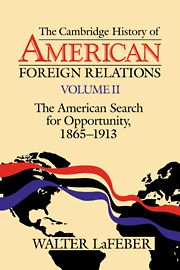Book contents
- Frontmatter
- 1 Springboards and strategies
- 2 The second Industrial Revolution at home and abroad
- 3 Race for empire
- 4 “America Will Take This Continent in Hand Alone”
- 5 Crossing the oceans
- 6 1893–1896: chaos and crises
- 7 The empire of 1898 – and upheaval
- 8 Pacific empire – and upheaval
- 9 Theodore Roosevelt: conservative as revolutionary
- 10 William Howard Taft and the age of revolution
- Conclusion: The 1865–1913 Era Restated
- Bibliographic Essay
- Index
- THE CAMBRIDGE HISTORY OF AMERICAN FOREIGN RELATIONS
- References
10 - William Howard Taft and the age of revolution
Published online by Cambridge University Press: 28 March 2008
- Frontmatter
- 1 Springboards and strategies
- 2 The second Industrial Revolution at home and abroad
- 3 Race for empire
- 4 “America Will Take This Continent in Hand Alone”
- 5 Crossing the oceans
- 6 1893–1896: chaos and crises
- 7 The empire of 1898 – and upheaval
- 8 Pacific empire – and upheaval
- 9 Theodore Roosevelt: conservative as revolutionary
- 10 William Howard Taft and the age of revolution
- Conclusion: The 1865–1913 Era Restated
- Bibliographic Essay
- Index
- THE CAMBRIDGE HISTORY OF AMERICAN FOREIGN RELATIONS
- References
Summary
President William Howard Taft and Secretary of State Philander C. Knox were responsible for conducting U.S. foreign policy when, between 1909 and 1913, two generations of American diplomatic history climaxed in Canada, Central America, Mexico, and Asia. Viewed by many scholars, not incorrectly, as sometimes lethargic and often unimaginative, Taft and Knox shared a love for the law, and the respect for property, precedent, compromise, peaceful settlements, and the power of money that are common to many lawyers. Taft was happiest not as president but later when he served as chief justice of the Supreme Court. “The truth is,” he said then, “that in my present life I don’t remember that I ever was President.”
Taft had a superb legal mind. Knox, like his predecessor, Elihu Root, ranked at the top of the best corporate lawyers in a nation dominated by corporations. Taft, moreover, sported a résumé that included being governor-general of the Philippines, secretary of war, Theodore Roosevelt’s diplomatic troubleshooter, and the successor handpicked by TR himself. The Rough Rider quickly regretted his selection, although he probably would have been disappointed regardless of whom he had chosen to succeed him. Roosevelt, moreover, along with his several predecessors in the White House, had bequeathed to Taft and Knox foreign policies that finally triggered a series of disorders, indeed revolutions in several instances, that neither Taft nor anyone else could understand and resolve. The uprisings over the tariff and in Central America, Mexico, and China were fitting conclusions to the previous half century. Taft and Knox had the misfortune to be in the White House and the State Department when many of those deeply rooted policies bore bitter fruit for the United States.
- Type
- Chapter
- Information
- The Cambridge History of American Foreign Relations , pp. 210 - 233Publisher: Cambridge University PressPrint publication year: 1993



